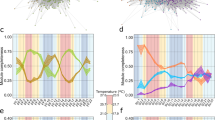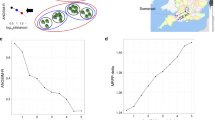Abstract
Understanding the processes that generate patterns of community structure is a central focus of ecological research. With that aim, we manipulated the structure of bacterial activated sludge to test the influence of the species richness and composition of bacterial communities on the dynamics of activated sludge floc assembly in lab-scale bioreactors. Bacterial community structure was analyzed using denaturing gradient gel electrophoresis of RT-PCR amplified 16S rRNA. Fingerprinting of four parallel reactors, started with the same source communities added in different proportions, converged to patterns that were more similar than expected by chance, suggesting a deterministic selection in floc development. Evidence for neutral dynamics was suggested by the dependence of the rate of replacement of species (bacterial taxa–time relationships) on the number of available species in the source community. Further indication of stochastic dynamics was obtained by the application of the Sloan neutral model for prokaryotes. The fitting of the observed data to the model predictions revealed that the importance of the stochastic component increased with the size of the reservoir of species richness from which the community is drawn. Taken together, the results illustrate how both neutral and deterministic dynamics operate simultaneously in the assembly of the bacterial floc and show that the balance of the two depends on the richness of the source community.





Similar content being viewed by others
References
Adler PB, Hillerislambers J, Levine JM (2007) A niche for neutrality. Ecol Lett 10:95–104
Akarsubasi AT, Eyice O, Miskin I, Head IM, Curtis TP (2009) Effect of sludge age on the bacterial diversity of bench scale sequencing batch reactors. Environ Sci Technol 43:2950–2956
Ayarza JM, Guerrero LD, Erijman L (2010) Nonrandom assembly of bacterial populations in activated sludge flocs. Microb Ecol 59:436–444
JdC B, Davenport RJ, Donnelly T, Curtis TP (2008) The microbial diversity of laboratory-scale wetlands appears to be randomly assembled. Water Res 42:3182–3190
Bell G (2000) The distribution of abundance in neutral communities. Am Nat 155:606–617
Bell T, Ager D, Song JI, Newman JA, Thompson IP, Lilley AK, van der Gast CJ (2005) Larger islands house more bacterial taxa. Science 308:1884
Carrero-Colon M, Nakatsu CH, Konopka A (2006) Microbial community dynamics in nutrient-pulsed chemostats. FEMS Microbiol Ecol 57:1–8
Chase JM (2007) Drought mediates the importance of stochastic community assembly. Proc Natl Acad Sci USA 104:17430–17434
Collins G, Mahony T, O’Flaherty V (2006) Stability and reproducibility of low-temperature anaerobic biological wastewater treatment. FEMS Microbiol Ecol 55:449–458
Cook KL, Garland JL, Layton AC, Dionisi HM, Levine LH, Sayler GS (2006) Effect of microbial species richness on community stability and community function in a model plant-based wastewater processing system. Microb Ecol 52:725–737
Curtis TP, Head IM, Graham DW (2003) Theoretical ecology for engineering biology. Environ Sci Technol 37:64A–70A
Curtis TP, Sloan WT (2004) Prokaryotic diversity and its limits: microbial community structure in nature and implications for microbial ecology. Curr Opin Microbiol 7:221–226
Daims H, Taylor MW, Wagner M (2006) Wastewater treatment: a model system for microbial ecology. Trends Biotechnol 24:483–489
Enright AM, Collins G, O’Flaherty V (2007) Temporal microbial diversity changes in solvent-degrading anaerobic granular sludge from low-temperature (15 degrees C) wastewater treatment bioreactors. Syst Appl Microbiol 30:471–482
Falk MW, Song KG, Matiasek MG, Wuertz S (2009) Microbial community dynamics in replicate membrane bioreactors - Natural reproducible fluctuations. Water Res 43:842–852
Fernandez A, Huang S, Seston S, Xing J, Hickey R, Criddle C, Tiedje J (1999) How stable is stable? Function versus community composition. Appl Environ Microbiol 65:3697–3704
Ge Y, He JZ, Zhu YG, Zhang JB, Xu Z, Zhang LM, Zheng YM (2008) Differences in soil bacterial diversity: driven by contemporary disturbances or historical contingencies? ISME J 2:254–264
Gentile ME, Jessup CM, Nyman JL, Criddle CS (2007) Correlation of functional instability and community dynamics in denitrifying dispersed-growth reactors. Appl Environ Microbiol 73:680–690
Gentile ME, Lynn Nyman J, Criddle CS (2007) Correlation of patterns of denitrification instability in replicated bioreactor communities with shifts in the relative abundance and the denitrification patterns of specific populations. ISME J 1:714–728
Gravel D, Canham CD, Beaudet M, Messier C (2006) Reconciling niche and neutrality: the continuum hypothesis. Ecol Lett 9:399–409
Head IM, Saunders JR, Pickup RW (1998) Microbial evolution, diversity, and ecology: a decade of Ribosomal RNA analysis of uncultivated microorganisms. Microb Ecol 35:1–21
Hong H, Pruden A, Reardon KF (2007) Comparison of CE-SSCP and DGGE for monitoring a complex microbial community remediating mine drainage. J Microbiol Methods 69:52–64
Horner-Devine MC, Carney KM, Bohannan BJ (2004) An ecological perspective on bacterial biodiversity. Proc Biol Sci 271:113–122
Hoshino T, Terahara T, Yamada K, Okuda H, Suzuki I, Tsuneda S, Hirata A, Inamori Y (2006) Long-term monitoring of the succession of a microbial community in activated sludge from a circulation flush toilet as a closed system. FEMS Microbiol Ecol 55:459–470
Hubbell SP (2001) The unified neutral theory of biodiversity and biogeography. Princeton University Press, Princeton
Kaewpipat K, Grady CP Jr (2002) Microbial population dynamics in laboratory-scale activated sludge reactors. Water Sci Technol 46:19–27
Kampfer P, Erhart R, Beimfohr C, Bohringer J, Wagner M, Amann R (1996) Characterization of bacterial communities from activated sludge: culture-dependent numerical identification versus in situ identification using group- and genus-specific rRNA-targeted oligonucleotide probes. Microb Ecol 32:101–121
Konopka A, Carrero-Colon M, Nakatsu CH (2007) Community dynamics and heterogeneities in mixed bacterial communities subjected to nutrient periodicities. Environ Microbiol 9:1584–1590
Langenheder S, Lindstrom ES, Tranvik LJ (2006) Structure and function of bacterial communities emerging from different sources under identical conditions. Appl Environ Microbiol 72:212–220
Leibold MA, Holyoak M, Mouquet N, Amarasekare P, Chase JM, Hoopes MF, Holt RD, Shurin JB, Law R, Tilman D, Loreau M, Gonzalez A (2004) The metacommunity concept: a framework for large scale community ecology? Ecol Lett 7:601–613
Loreau M (2000) Biodiversity and ecosystem functioning: recent theoretical advances. Oikos 91:3–17
Lozada M, Basile L, Erijman L (2007) Impact of non-ionic surfactant on the long-term development of lab-scale-activated sludge bacterial communities. Res Microbiol 158:712–717
Lozada M, Figuerola EL, Itria RF, Erijman L (2006) Replicability of dominant bacterial populations after long-term surfactant-enrichment in lab-scale activated sludge. Environ Microbiol 8:625–638
Manefield M, Whiteley A, Curtis T, Watanabe K (2007) Influence of sustainability and immigration in assembling bacterial populations of known size and function. Microb Ecol 53:348–354
McGuinness LM, Salganik M, Vega L, Pickering KD, Kerkhof LJ (2006) Replicability of bacterial communities in denitrifying bioreactors as measured by PCR/T-RFLP analysis. Environ Sci Technol 40:509–515
Muyzer G, Smalla K (1998) Application of denaturing gradient gel electrophoresis (DGGE) and temperature gradient gel electrophoresis (TGGE) in microbial ecology. Antonie Leeuwenhoek 73:127–141
Nadarajah N, Grant Allen D, Fulthorpe RR (2007) Effects of transient temperature conditions on the divergence of activated sludge bacterial community structure and function. Water Res 41:2563–2571
Palacios C, Zettler E, Amils R, Amaral-Zettler L (2008) Contrasting microbial community assembly hypotheses: a reconciling tale from the Rio Tinto. PLoS ONE 3:e3853
Pender S, Toomey M, Carton M, Eardly D, Patching JW, Colleran E, O’Flaherty V (2004) Long-term effects of operating temperature and sulphate addition on the methanogenic community structure of anaerobic hybrid reactors. Water Res 38:619–630
Possemiers S, Verthé K, Uyttendaele S, Verstraete W (2004) PCR-DGGE-based quantification of stability of the microbial community in a simulator of the human intestinal microbial ecosystem. FEMS Microbiol Ecol 49:495–507
Ramette A, Tiedje JM (2007) Biogeography: an emerging cornerstone for understanding prokaryotic diversity, ecology, and evolution. Microb Ecol 53:197–207
Raup DM, Crick RE (1979) Measurement of faunal similarity in paleontology. J Paleontol 53:1213–1227
Redford AJ, Fierer N (2009) Bacterial succession on the leaf surface: a novel system for studying successional dynamics. Microb Ecol 58:189–198
Riviére D, Desvignes V, Pelletier E, Chaussonnerie S, Guermazi S, Weissenbach Li T, Camacho P, Sghir A (2009) Towards the definition of a core of microorganisms involved in anaerobic digestion of sludge. ISME J 3(6):700–714
Roeselers G, Zippel B, Staal M, van Loosdrecht M, Muyzer G (2006) On the reproducibility of microcosm experiments—different community composition in parallel phototrophic biofilm microcosms. FEMS Microbiol Ecol 58:169–178
Rosenzweig ML (1995) Species diversity in space and time. Cambridge University Press, Cambridge
Rowan AK, Snape JR, Fearnside D, Barer MR, Curtis TP, Head IM (2003) Composition and diversity of ammonia-oxidising bacterial communities in wastewater treatment reactors of different designtreating identical wastewater. FEMS Microbiol Ecol 43:195–206
Saikaly PE, Stroot PG, Oerther DB (2005) Use of 16S rRNA gene terminal restriction fragment analysis to assess the impact of solids retention time on the bacterial diversity of activated sludge. Appl Environ Microbiol 71:5814–5822
Sloan WT, Lunn M, Woodcock S, Head IM, Nee S, Curtis TP (2006) Quantifying the roles of immigration and chance in shaping prokaryote community structure. Environ Microbiol 8:732–740
Sloan WT, Woodcock S, Lunn M, Head IM, Curtis TP (2007) Modeling taxa-abundance distributions in microbial communities using environmental sequence data. Microb Ecol 53:443–455
Smalla K, Oros-Sichler M, Milling A, Heuer H, Baumgarte S, Becker R, Neuber G, Kropf S, Ulrich A, Tebbe CC (2007) Bacterial diversity of soils assessed by DGGE, T-RFLP and SSCP fingerprints of PCR-amplified 16S rRNA gene fragments: do the different methods provide similar results? J Microbiol Methods 69:470–479
Suzuki MT, Taylor LT, DeLong EF (2000) Quantitative analysis of small-subunit rRNA genes in mixed microbial populations via 5′-nuclease assays. Appl Environ Microbiol 66:4605–4614
Tap J, Mondot S, Levenez F, Pelletier E, Caron C, Furet J, Ugarte E, Muñoz-Tamayo R, Paslier DLE, Nalin R, Dore J, Leclerc M (2009) Towards the human intestinal microbiota phylogenetic core. Environ Microbiol 11:2574–2784
van der Gast CJ, Ager D, Lilley AK (2008) Temporal scaling of bacterial taxa is influenced by both stochastic and deterministic ecological factors. Environ Microbiol 10:1411–1418
Wagner M, Loy A (2002) Bacterial community composition and function in sewage treatment systems. Curr Opin Biotechnol 13:218–227
White EP, Adler PB, Lauenroth WK, Gill RA, Greenberg D, Kaufman DM, Rassweiler A, Rusak JA, Smith MD, Steinbeck JR, Waide RB, Yao J (2006) A comparison of the species/time relationship across ecosystems and taxonomic groups. Oikos 112:185–195
Wittebolle L, Van Vooren N, Verstraete W, Boon N (2009) High reproducibility of ammonia-oxidizing bacterial communities in parallel sequential batch reactors. J Appl Microbiol 107:385–394
Woodcock S, van der Gast CJ, Bell T, Lunn M, Curtis TP, Head IM, Sloan WT (2007) Neutral assembly of bacterial communities. FEMS Microbiol Ecol 62:171–180
Acknowledgments
We thank Dr. Mario Aguilar (UNLP) for the use of GelCompar software and Dr. Thomas Jovin for help with the calculations based on Mathematica. This work was partially funded by a grant from FONCyT (PICT 2005 No. 31705). L.E. is a career member of CONICET.
Author information
Authors and Affiliations
Corresponding author
Rights and permissions
About this article
Cite this article
Ayarza, J.M., Erijman, L. Balance of Neutral and Deterministic Components in the Dynamics of Activated Sludge Floc Assembly. Microb Ecol 61, 486–495 (2011). https://doi.org/10.1007/s00248-010-9762-y
Received:
Accepted:
Published:
Issue Date:
DOI: https://doi.org/10.1007/s00248-010-9762-y




